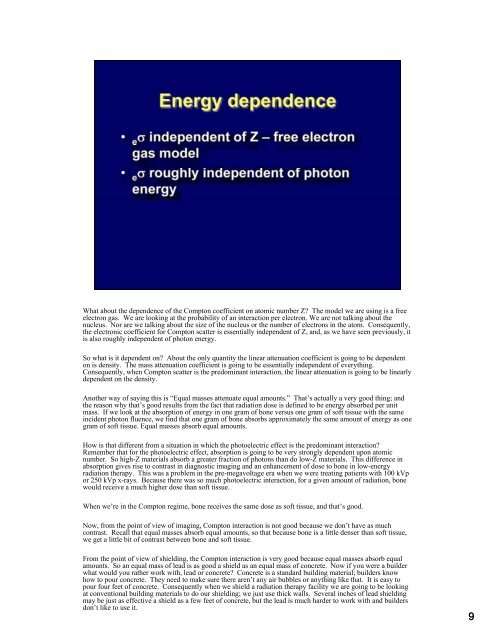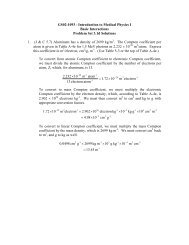link to lecture transcript - UT-H GSBS Medical Physics Class Site
link to lecture transcript - UT-H GSBS Medical Physics Class Site
link to lecture transcript - UT-H GSBS Medical Physics Class Site
You also want an ePaper? Increase the reach of your titles
YUMPU automatically turns print PDFs into web optimized ePapers that Google loves.
What about the dependence of the Comp<strong>to</strong>n coefficient on a<strong>to</strong>mic number Z? The model we are using is a free<br />
electron gas. We are looking at the probability of an interaction per electron. We are not talking about the<br />
nucleus. Nor are we talking about the size of the nucleus or the number of electrons in the a<strong>to</strong>m. Consequently,<br />
the electronic coefficient for Comp<strong>to</strong>n scatter is essentially independent of Z, and, as we have seen previously, it<br />
is also roughly independent of pho<strong>to</strong>n energy.<br />
So what is it dependent on? About the only quantity the linear attenuation coefficient is going <strong>to</strong> be dependent<br />
on is density. The mass attenuation coefficient is going <strong>to</strong> be essentially independent of everything.<br />
Consequently, when Comp<strong>to</strong>n scatter is the predominant interaction, the linear attenuation is going <strong>to</strong> be linearly<br />
dependent on the density.<br />
AAnother th way of f saying i this thi is i “Equal “E l masses attenuate tt t equal l amounts.” t ” That’s Th t’ actually t ll a very good d thing; thi and d<br />
the reason why that’s good results from the fact that radiation dose is defined <strong>to</strong> be energy absorbed per unit<br />
mass. If we look at the absorption of energy in one gram of bone versus one gram of soft tissue with the same<br />
incident pho<strong>to</strong>n fluence, we find that one gram of bone absorbs approximately the same amount of energy as one<br />
gram of soft tissue. Equal masses absorb equal amounts.<br />
How is that different from a situation in which the pho<strong>to</strong>electric effect is the predominant interaction?<br />
Remember that for the pho<strong>to</strong>electric effect, absorption is going <strong>to</strong> be very strongly dependent upon a<strong>to</strong>mic<br />
number. So high-Z materials absorb a greater fraction of pho<strong>to</strong>ns than do low-Z materials. This difference in<br />
absorption gives rise <strong>to</strong> contrast in diagnostic imaging and an enhancement of dose <strong>to</strong> bone in low-energy<br />
radiation therapy therapy. This was a problem in the pre-megavoltage pre megavoltage era when we were treating patients with 100 kVp<br />
or 250 kVp x-rays. Because there was so much pho<strong>to</strong>electric interaction, for a given amount of radiation, bone<br />
would receive a much higher dose than soft tissue.<br />
When we’re in the Comp<strong>to</strong>n regime, bone receives the same dose as soft tissue, and that’s good.<br />
Now, from the point of view of imaging, Comp<strong>to</strong>n interaction is not good because we don’t have as much<br />
contrast. Recall that equal masses absorb equal amounts, so that because bone is a little denser than soft tissue,<br />
we get a little bit of contrast between bone and soft tissue.<br />
From the point of view of shielding, the Comp<strong>to</strong>n interaction is very good because equal masses absorb equal<br />
amounts. So an equal mass of lead is as good a shield as an equal mass of concrete. Now if you were a builder<br />
what would you rather work with, lead or concrete? Concrete is a standard building material; builders know<br />
how <strong>to</strong> pour concrete. They need <strong>to</strong> make sure there aren’t any air bubbles or anything like that. It is easy <strong>to</strong><br />
pour four feet of concrete. Consequently when we shield a radiation therapy facility we are going <strong>to</strong> be looking<br />
at conventional building materials <strong>to</strong> do our shielding; we just use thick walls. Several inches of lead shielding<br />
may be just as effective a shield as a few feet of concrete, but the lead is much harder <strong>to</strong> work with and builders<br />
don’t like <strong>to</strong> use it.<br />
9





